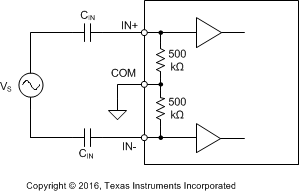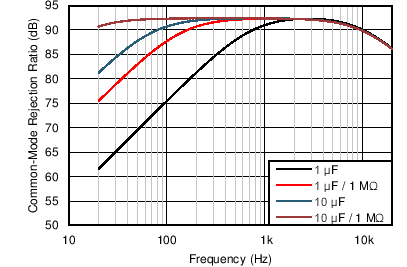ZHCSGP4C August 2017 – May 2019 INA1650-Q1 , INA1651-Q1
PRODUCTION DATA.
8.1.4 Input AC Coupling
The signal path in most audio systems is typically AC-coupled to avoid the propagation of DC voltages, which can potentially damage loudspeakers or saturate power amplifiers. The capacitor values must be selected to pass the desired bandwidth of audio signals. The high-pass corner frequency is calculated with Equation 5:

 Figure 49. AC-Coupling Capacitors Form a High-Pass Filter With INA165x-Q1 Input Resistors
Figure 49. AC-Coupling Capacitors Form a High-Pass Filter With INA165x-Q1 Input Resistors Although the input resistors of the INA165x-Q1 are matched typically within 0.01%, large capacitors are usually mismatched. The mismatch in the values of the AC-coupling capacitors causes the corner frequencies at the two signal inputs (IN+ and IN–) to be different, which can degrade CMRR at low frequency. For this reason, TI recommends placing the high-pass corner frequency well below the audio bandwidth and to use a resistor in series with the COM pin (RCOM), as shown in Figure 44 if possible. See the Common-Mode Input Impedance section for more information on placing a resistor in series with the COM pin. Figure 50 shows the effect of a 5% mismatch in the values of the input AC-coupling capacitors with and without an RCOM resistor. Comparing CMRR at 100 Hz: 1-µF AC-coupling capacitors with a 5% mismatch degrade the CMRR to 75 dB, while 10-µF capacitors and a 1-MΩ RCOM resistor shows 92 dB of CMRR.
 Figure 50. CMRR Degradation Due to a 5% Mismatch in AC-Coupling Capacitors
Figure 50. CMRR Degradation Due to a 5% Mismatch in AC-Coupling Capacitors